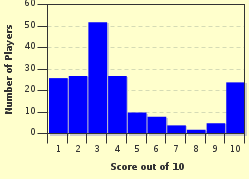Quiz Answer Key and Fun Facts
1. A triangle is formed by connecting the vertices of three points; (0,0), (3,2), and (4m,-1). The line y = mx is then drawn through the triangle, splitting it into two equal parts. What is the sum of all possible values of m?
2. How many positive integers are there that are meet all of the following conditions?
-Less than 1,000,000
-Perfect cube
-Multiple of 72
3. Since our economy is so bad, we've decided to implement a new coin system, where each coin has a different value. There are five different coins of five different colors: red, blue, green, yellow, and white. The way the system works is that 1 red coin = n blue coins, 1 blue coin = n green coins, 1 green coin = n yellow coins, and 1 yellow coin = n white coins. In a transaction, someone with 12 blue coins and 168 white coins receives 1 red coin, 33 green coins, and 38 yellow coins. What is the sum of all possible values of n? (Note: n can NOT have a negative value OR a value of zero)
4. Two cogs, one bigger than the other, both start out pointing due north. One cog spins at a rate of 80 revolutions per minute, while the other spins at a rate of 67 1/2 revolutions per minute. After how many seconds will both cogs be pointing due north again for the first time?
5. Assume N(z) = 10...064, where z is the number of zeros between the 1 and the 6. The value of N(z) can then be put into the form 2^n * k, where k is any positive whole number not divisible by 2. What is the maximum value of n for any value of z?
6. Three circles are drawn tangent to each other so that each circle touches each other circle once. Each circle has a radius of 1. A fourth circle is then drawn around these three circles so that it is internally tangent to all three circles. The radius of this circle can be represented as (a + b * sqrt(c)) / d, where a, b, c, and d are all in their simplest forms. What is the value of a + b + c + d?
7. Any integer can be expressed as the difference of the squares of two different integers.
8. What is the sum of all solutions to the following problem?
49^x + 7^(1-2x) = 8
9. The first three terms of an arithmetic sequence are 3x - 5, 2x + 3, and 5x - 1, respectively. What is the 100th term of this sequence?
10. 30 people are in the same room with one another. Assuming no one was born on February 29th, what is the probability that at least two people in the room have the same birthday?
Source: Author
bfguitarhero
This quiz was reviewed by FunTrivia editor
crisw before going online.
Any errors found in FunTrivia content are routinely corrected through our feedback system.

